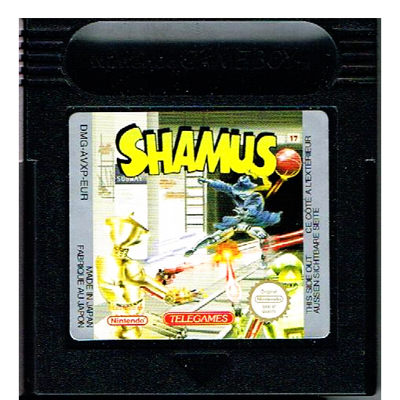SHAMUS GAMEBOY COLOR
SHAMUS GAMEBOY COLOR - DMG-AVXP-EUR
Shamus is a flip screen action adventure game written by William Mataga (now Cathryn Mataga) and published by Synapse Software. Originally released for the Atari 8-bit computers in 1982, it was ported to the VIC-20, Commodore 64, TRS-80 Color Computer, TI-99/4A, and IBM PC. Several of these ports were made by Atarisoft. Ihor Wolosenko, co-founder of Synapse, noted that it was Shamus that really put the company on the map by giving it a reputation for quality. It was followed by a sequel, Shamus: Case II, with the same characters but different gameplay.
Mataga's original version was 16K in size and released on disk and tape for the Atari 8-bit family, and later sold by Atari on cartridge following the launch of the Atari XEGS in 1987. The VIC-20 port was 8K and contained only 32 levels (unlike the 128 in every other version). In 1999, Mataga developed a remake for the Game Boy Color, and later, both Shamus and Shamus: Case II for iOS.
Funeral March of a Marionette, the theme song from Alfred Hitchcock Presents, plays on the title screen.
Inspired by the arcade game Berzerk the objective of the game is to navigate the eponymous robotic detective through a 4-skill level, 128-room maze of electrified walls. The ultimate goal at the end of this journey is "The Shadow's Lair". Shamus differs from Berzerk in that there's a persistent world instead of rooms that are randomly generated each time they are entered. There are also items to collect: bottles containing extra lives, mystery question marks, and keys which open exits.
Opposing the player are a number of robotic adversaries, including spiral drones, robo droids and snap jumpers. Shamus is armed with "Ion SHIVs", SHIV being an acronym for Short High Intensity Vaporizer, and is able to hurl up to two at a time at his enemies. Like many other games in this genre, touching an electrified wall results in instantaneous death. Upon the completion of each level, the gameplay speeds up, increasing the chances of running into a wall.
The main gameplay involves clearing the room of all enemies, picking up special items on the way and then leaving through an exit. Upon returning to the room, the enemies are regenerated and returned to their original positions. In exactly the same way as Berzerk, the player is attacked if he or she spends too much time in a room. In this case, the Shadow himself emerges from off-screen and hops directly at Shamus, unhindered by the walls. If shot, the Shadow briefly freezes in place.
The game was unique in that its combination of locks and keys required the player to complete each of its four levels in a particular order. To complete the game in its entirety would take several hours, which combined with the lack of a pause function (except on the IBM version), the necessity of remembering the location of dozens of rooms and keys, and the frenetic gameplay meant that this was extremely difficult to accomplish.
Each maze layout is named after a famous fictional detective or agent.
ENDAST KASSETT

